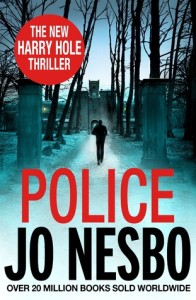“Just as most climbers in the world have never got as far as the foothills of K2, you can work all your life without ever being on a case like this one. If this case had been cracked in the first weeks it would soon have been forgotten. For what is it that all legendary criminal cases in history have in common?…They took time. They were an uphill climb.” – Mikael Bellman, Chief of Police, Oslo

Cover for the international edition.
He’s done it again! With over twenty million copies sold, and over a dozen Nordic prizes and nominations for crime writing under his belt, Norwegian author Jo Nesbo is certainly at the top of his game, and this novel, which fans will almost certainly agree is the best one yet, is sure to win him even greater recognition and even more readers. The dramatic and terrifying teasers at the end of this novel also guarantee that devoted readers will be waiting in line for the next novel in this Oslo based series, which centers on the troubled and alcoholic Inspector Harry Hole and those he has worked with in the Oslo Police Department. In Phantom, the preceding novel, Harry Hole suffers grievous injuries, and this novel begins where that one left off.
(No spoilers here.) Officer Anton Mittet has been guarding a comatose patient in a private room in the basement of the Rikshospital for months. Even he does not know the name of the patient, who is “a potential witness…If he wakes up, he probably has the goods to bring down some important heroin dealers in Oslo. Plus he can tell us who was trying to kill him.” What the reader does know from the introduction is that “Isabelle Skoyen, the Councillor for Social Affairs at Oslo City Hall and Mikael Bellman, the newly appointed Chief of Police, hope they [will] never see him again. That no one [will] see him again,” a strange reaction, one might think, but one which readers of Phantom will appreciate (and which new readers will come to understand from the action which follows). When the patient appears to be coming out of the coma, panic sets in among his enemies and those who have much to lose.
Many familiar characters appear in this novel – Beate Lonn, the head of Krimteknisk, who has a reputation as a kind of “Rain Woman,” thanks to the fact that she is one of only thirty people in the known world who has the ability never to forget a face; Stale Aune, a psychologist, who provides insights into the criminal mind and its motivations; Gunnar Hagen, head of the Crime Squad; Katrine Bratt, recently released from a stay in a mental hospital, a woman who is able to “see patterns where others see only chance”; and Bjorn Holm, an expert in forensics. All these officers have worked with Harry Hole, and as a series of new crimes terrorizes Oslo, they miss his iconoclastic approach to law enforcement and his willingness to flout the rules if that will ensure the right outcome.
Both Kripos and the Crime Squad are collaborating here on a series of cases in which a serial killer is murdering policemen who have been unsuccessful in solving sensational murder cases in which they have been involved at some time in the past. Each policeman or investigator is murdered on the anniversary of that unsolved murder, and usually in the same location as that murder. The first policeman dies a grisly death at a ski slope at night, and the similarities between this death and a past unsolved case are immediately obvious to the investigators. Subsequent murders of police involve “sex, sadism, and the use of knives,” and frequently violence to the face with a blunt object. One murder may be a homosexual hate crime. As the pressure on Mikael Bellman, the new (and self-serving) Police Chief ratchets up, he and Isabelle Skoyen, the Councillor of Social Affairs at City Hall each try to protect turf by taking credit for some progress and blaming others for impeding it.

The Police College in Oslo, where several investigators have been teaching and where Silje Gravseng is a student.
As many new characters and suspects are introduced, Nesbo, always clever in creating bizarre details to make these characters memorable, also focuses on their psychiatric problems, using Stale Aune as the fictional mouthpiece to provide this information. Some of the crimes unfolding here are grotesque – even nauseating – and as pressure grows to solve these, the author shows how investigators from the lowliest newbie in the department to the very top of the hierarchy become desperate, even panicked, as they face their day to day lives. The biggest question is how the murderer gets a police officer to appear at the scene of the crime (and the scene of what becomes his/her own murder) on the date of a past murder which s/he has investigated and failed to solve, a date s/he would certainly remember.

A postcard of Svolvaergeita in Lofoten, found in a suspect’s apartment, provides an important clue. Photo by Doug Pearson
Nesbo, always an author who enjoys surprising or shocking his readers, plays a wicked cat-and-mouse game with the reader which goes way beyond the usual suspense. Giving the reader just enough information, he sets up overt expectations and encourages the reader to draw conclusions which match those of the investigators. Just when it looks as if some real progress will be made in the solution to one of the many crimes here, however, Nesbo suddenly jerks the reader around and shows how all the reader’s expectations are wrong, and certainly naive. It is a more show-offy style for Nesbo than we are accustomed to, and very quickly the reader decides not to be taken in again and to distrust every new piece of information. As the need to solve various crimes becomes greater, and the number of pages left in the book gets smaller, however, the reader begins to trust once again that some new revelation will match his/her own expectations regarding the ending of the book. And virtually every time, Nesbo will again jerk the chain and show how wrong we were to trust ourselves – and him.
Even for those who are new to Nesbo, this may be a can’t-put-it-downer, but I would suggest that the new reader begin with Phantom, so s/he fully understands the background and characters on which this novel depends. Amazon reviewers in the UK, where this novel was released a month ahead of the US release, have already shown that many newbies do love this novel. Those who have read Phantom, however, have a much greater appreciation for the characters and the author’s ability to devise a complex plot, tying up the loose ends for major crimes but leaving a few questions. In the case of this novel, there are major teasers in the last couple of pages which I suspect will guarantee the purchase of the next novel in the series.
ALSO reviewed here: THE BAT, THE REDBREAST, NEMESIS, THE DEVIL’S STAR, THE REDEEMER, THE SNOWMAN, THE LEOPARD, PHANTOM, COCKROACHES (1998), THE SON (2014), BLOOD ON SNOW (2015), MIDNIGHT SUN (2016), THE THIRST (2017), KNIFE (2019)
Photos, in order: The author’s photo by Ruth Fremson appears on http://www.nytimes.com
Night Skiing may be found on http://www.brokenriver.co.nz
A Volvo Amazon, more than forty years old, is the car of choice for two different characters in this novel: http://www.cargurus.com/
The Police College in Oslo, where some of the police, past and present, are instructors and where Silje Gravseng is a student, is from http://en.wikipedia.org Photo by GAD
The photograph of Solvaergeita in Lofoten is may be found on http://www.allposters.com/ Photo by Doug Pearson. A postcard of this scene in a suspect’s room provides a clue for the police.



